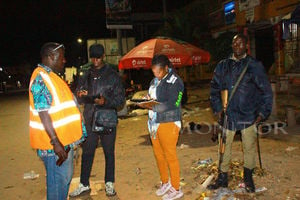DRC Crisis: Injured Congolese arrive in Hoima

Congolese refugees board trucks at Sebagoro landing site.
What you need to know:
- On Friday, upto 3,115 individuals arrived at Sebagoro landing site, 502 arrived at Nsonga landing while 175 arrived at Senjojo landing site.
- United Nations agencies such as United Nations High commission for Refugees (UNHCR), World Food programme (WFP) and UNICEF are providing water, food, household essentials and sanitation facilities to the refugees.
Hoima District continues to receive thousands of Congolese nationals who are fleeing from fighting that erupted in Eastern Democratic Republic of Congo (DRC).
Four of the refugees arrived with injuries on their heads and hands, a covert security source told this reporter.
They said they got injuries as they fled from the raging tribal fight in the mineral-rich eastern DRC which boarders with Uganda and Rwanda. Eastern DRC is infested with rebels and militia groups.
Ms Jolly Kebirungi, the commandant of Kyangwali refugee resettlement scheme confirmed that the injured refugees received first aid after arriving in Uganda before they were evacuated to Hoima regional referral hospital for treatment.
Citing international protocols that protect refugees, officials in Office of the Prime Minister (OPM) and Hoima regional referral hospital declined to reveal the identities of the injured refugees.
The refugees are reportedly fleeing from a tribal fight between the Bagegere and the Lendu. There Congolese have told Ugandan authorities that houses are being torched and people are being attacked with machetes and firearms.
The displaced Congolese nationals include the Hema, Bagegere, Kebu, Lendu and the Alurs, security officials have said.
They are said to be fleeing from Tchoma, Kasenyi, Joo, Bulambira, Nyamwamba, Varamo in Ituri province of DRC.
On Friday, upto 3,115 individuals arrived at Sebagoro landing site, 502 arrived at Nsonga landing while 175 arrived at Senjojo landing site.
“Out of the 502 refugees that arrived at Nsonga landing site, only 39 accepted to be registered and receive protection,” said Kebirungi, the commandant of Kyangwali refugee resettlement scheme.
The 463 insisted on staying at the landing site with hope that they will soon return to their home country.
“We do not force anybody to receive protection. It is voluntary,” said Kebirungi.
Security officials who are screening the refugees said those declining to be taken to Kyangwali refugee camp are businessmen who arrived with their private boats, belongings and some merchandise.
Since fighting erupted in DRC on December 19, 2017, a cumulative number of refugees that had arrived in Hoima District by Friday evening stood at 14,922, OPM officials said.
Among the refugees are hundreds of unaccompanied minors who were separated from their parents and guardians.
The Red cross Society is conducting child tracing aimed at reuniting the minors with their families, OPM officers said.
The Hoima Resident District Commissioner, Mr John Stephen Ekoom who chairs the district security committee said the refugees are traveling by canoe boats across Lake Albert before arriving at various landing sites.
Mr Ekoom said a district disaster management committee comprised of security chiefs, humanitarian agencies and district technocrats is closely monitoring the influx of the refugees to ensure that it does not degenerate into a crisis.
United Nations agencies such as United Nations High commission for Refugees (UNHCR), World Food programme (WFP) and UNICEF are providing water, food, household essentials and sanitation facilities to the refugees.
Kyangwali refugee resettlement scheme sits on a 142 square miles and hosts 35,791 refugees from DRC, Sudan, Burundi and Rwanda.
After being evacuated from landing sites on Lake Albert, the new arrivals are received at Kagoma reception centre where they are registered before being allocated plots in Malembo, Mombasa and Maratatu areas within Kyangwali refugee resettlement scheme.



